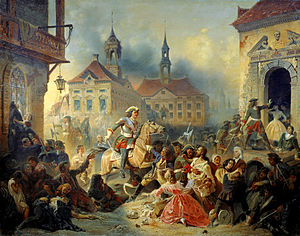| Narva | ||
 | ||
Coat of arms and flag  | ||
| Salutation | Baltic pearl | |
|---|---|---|
| State | Estonia | |
| Region | Ida-Virumaa | |
| Altitude | 25 m a.s.l. | |
| Surface | 88.54 km² | |
| Inhabitants | 66 886 | |
| Prefix tel | 372 35 | |
| POSTAL CODE | from 20001 to 21020 | |
| Time zone | UTC 2 | |
Position
| ||
| Institutional website | ||
Narva (Narwa in German is Polish) is a city ofEstonia.
To know
Narva is located in northeastern Estonia, in the county of Ida-Virumaa, on the border with Russia, from which it is separated by the Narva River. This ancient - and historically very important - city is located just opposite the Russian city of IvangorodOnce united with Narva and then separated in the 1950s during the Soviet occupation, it is the third largest city in the country in terms of population, made up mostly of Russian speakers. The city is an industrial center as well as the main seat of the Narva eparchy, the Estonian Orthodox church.
Index
Background
Narva was founded in 1250, it was then sold in 1347 by the king of Denmark to the Teutonic knights of the Order of Sword Ports, later becoming an important trading center. In 1555 Narva was conquered by the Russians, at the outbreak of the Livonian War (1558-1582). The Swedes conquered the city in 1581, but the Russians besieged it repeatedly. On November 30, 1700, the Russians' attempt to seize the fortress failed: they were defeated by the Swedes. The Russian army, although very numerous, was composed of soldiers who, from the point of view of quality, they were absolutely not up to, for example, French or Swedish soldiers.

Symptomatic of this situation was precisely the battle of Narva, in the year 1700, in which almost 40,000 Russians were defeated by 10,000 Swedes who lost less than 700 soldiers against 15,000 (between dead and wounded) Russians. The Battle of Narva marked the beginning of the Great Northern War (1700 - 1721). With Peter the Great, the Russians regained possession of it (1704).
Narva's period of greatest commercial prosperity was the seventeenth century, also considered the golden age for city civil architecture. Until then, the city of Narva was mainly built of wood, so several times it was almost entirely destroyed by fires.
After a disastrous fire in 1659, the city was rebuilt again in a short time (about 30-40 years). Following this episode, the construction of only stone buildings was authorized, according to strict rules. Experts and workers were therefore invited here from Germany, the Netherlands and Sweden to design the structures of the new city. The desire of the Swedish government was to turn Narva into a perfect Swedish city and also an administrative center of the vast Province of Ingermanland. All this gave a precise purpose to the reconstruction. Furthermore, during the middle of the century there were some plans for the transformation of Narva into the second capital of Sweden, possibly usable as the new residence of the Royal family.
These projects were never carried out. In any case, the result was to give the center of Narva a unique architectural ensemble. The architecture of the old city combined local building traditions with typically Baroque elements, used in many nations of northern Europe, giving rise to an architectural style also known as "Narva Baroque". Sharp roofs, gates decorated with carved stone, architectural details in wrought iron, cloisters and galleries gave the city an air of solemnity and festivity.
The city was reconquered by Russia in 1704 and was part of the Russian Empire until the independence of Estonia in 1918.
On the opposite bank of the river is the fortress of Ivangorod, founded by the Grand Duke Ivan III of Moscovia in 1492, and which until the Second World War was part of the city of Narva. The Soviets, mutilating the incorporated Estonian territory, created two distinct cities: Narva and Ivangorod. Currently Ivangorod still remains Russian territory and is claimed by the Estonians under the 1920 Tartu Treaty.
In 1919 it was the capital of the Free State of the Estonian Workers' Community.
How to orient yourself
How to get
How to get around
What see
Events and parties
What to do
Shopping
How to have fun
Where to eat
Where stay
Safety
How to keep in touch
Around
- Narva-Jõesuu, a tourist resort on the shores of the Baltic Sea.
- Sillamäe, a wonderful coastal town
- Tartu, the cultural capital of Estonia on the banks of the Emajõgi and the nation's second city.
- Tallinn, capital and largest city of the nation
- Ivangorod, Russian city at a stone throwing from Narva
Useful information
- Touristic office, Pushkini 13, ☎ 372 356 01 84, @[email protected].
 Mon-Fri 09: 00-18: 00, Sat-Sun 10: 00-15: 00. At this office you will find highly trained staff who will be able to help you in English for any eventuality.
Mon-Fri 09: 00-18: 00, Sat-Sun 10: 00-15: 00. At this office you will find highly trained staff who will be able to help you in English for any eventuality.
Other projects
 Wikipedia contains an entry concerning Narva (city)
Wikipedia contains an entry concerning Narva (city) Commons contains images or other files on Narva (city)
Commons contains images or other files on Narva (city)

